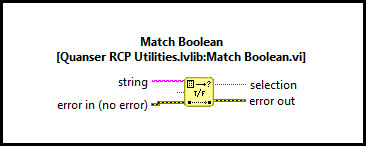
Match Boolean

| Owning Palette: | Utilities |
| Requirements: | Quanser Rapid Control Prototyping Toolkit, LabVIEW 2020 or newer |
Description
Returns true if the input string is "true", "yes", "y", "on" or "1". Returns false if the input string is "false", "no", "n", "off" or "0". If the input string is none of these values then it returns an error and the selection output is set to the default input.
Recommended Inputs  Recommended inputs need not be wired. They appear as simple text in the context help window for the VI.
Recommended inputs need not be wired. They appear as simple text in the context help window for the VI.

|
string is the input being compared to "false", "true", "no", "yes", "n", "y", "0" or "1". |

|
error in describes error conditions occurring before the VI executes. If an error has already occurred, the VI returns the value of the error in cluster in error out.
|
Optional Inputs  Optional inputs need not to be wired. They are indicated but not labelled in the context help window for the VI.
Optional inputs need not to be wired. They are indicated but not labelled in the context help window for the VI.

|
default is the value to output if the input is invalid. |
Outputs

|
selection is |
||||||

|
error out contains error information. If the error in cluster indicated an error, the error out cluster contains the same information. Otherwise, error out describes the error status of this VI.
|
Details
This VI returns true if the input string is "true", "yes", "y", "on" or "1". It returns false if the input string is "false", "no", "n", "off" or "0". If the input string is none of these values then it returns an error. The comparison is case-insensitive, so strings such as "True" and "False" also match, as do "ON" and "OFF".
Feedthrough Behaviour
All input/output pairs of this function have direct feedthrough behaviour.
Examples
There are currently no examples
See Also
| Match Enum |
Targets
|
Target |
Supported |
Comments |
|---|---|---|
|
Yes |
Fully supported. |

Copyright © Quanser Inc. This page was generated 2021-09-24. Submit feedback to Quanser about this page.
Link to this page.


